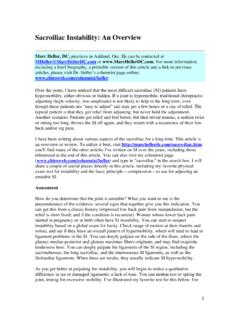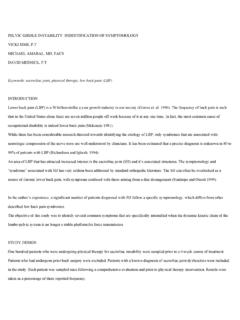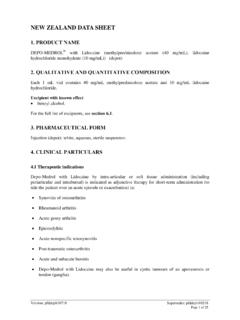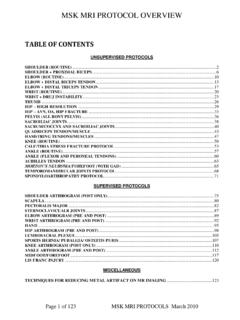Transcription of Sacroiliac Revisited: The Importance of Ligamentous Integrity
1 Sacroiliac revisited : The Importance of Ligamentous Integrity by Marc Heller, DC. When the Sacroiliac (SI) joint is difficult to stabilize, it is also very difficult for the patient to heal. In chiropractic, this has been elegantly expressed in the SOT world. Unstable sacroiliacs are easy to adjust, with a satisfying, audible release; but in my experience, this doesn't change the outcome. In my experience of motion palpation, the SI joint, even when unstable, can feel fixated and stuck. I suspect that the joint feels stuck because all of the muscles surrounding the joint are tight, trying desperately to keep the injured or dysfunctional joint as stable as possible.
2 What would lead us to suspect Sacroiliac instability? 1. The patient continues to return with continued lower back or buttock pain. 2. The patient shows continued indicators for SI instability, such as a positive arm fossa test for SOT category 2, palpatory findings of pelvic sagittal rotation (AS or PI ilium), and/or bogginess and/or "ropiness" on palpating the SI joint itself. You may have different indicators for SI problems; feel free to use them. The bottom line is that the patient is not changing or responding. The first time he or she stresses the joint - when lifting, jogging, sitting, etc.
3 - the joint subluxes again. I. think we need to address the Ligamentous and tendonous instability via actually restarting first-stage healing. What is first-stage healing? When a ligament or tendon is injured, it goes through a process of inflammation and lays down new tissue. This inflammation is a necessary part of the first-stage healing. This is another good reason not to use NSAIDs after injury, as they block the first stage of the healing process. In the unstable Sacroiliac , first-stage healing has stopped. The muscular/tendonous component now has a tendinopathy.
4 What is wrong with the tendons? I'll quote Warren Hammer: "What we really are seeing is an intratendinous degeneration due to aging, and microtrauma where there is collagen disorientation, disorganization and fiber separation."1. The ligament components have been studied less, but the problems are parallel, with degenerative changes leading to functional laxity. This can be hard to assess via joint mobility testing, as the muscles attempt to take over the stabilizing function and become tight. What ligaments and tendons tend to not be functional around the SI joint, and how should we assess and correct them?
5 Let's break it down into four separate accessible ligaments. These include the sacrotuberous ligament, the sacrospinous ligaments, the iliolumbar ligaments, and the long posterior Sacroiliac ligaments. All of these can be involved in SI. instability. Note that this palpation requires a pressure deep into the buttock region, often pushing through some fairly thick, soft tissue. This also involves touching an area that is rarely assessed, and that may be connected with old abuse memory patterns. Tell the patient what you are going to do, why you are assessing this area, and ask for their explicit permission.
6 You may want to bring an assistant into the room; you may want to get an informed consent. Use good judgment. I will use a broad definition of the sacrotuberous ligament, including the parts of the Sacroiliac ligaments that interdigitate with it. Evaluate the sacrotuberous ligaments for tenderness with digital pressure along three areas, all at junctions of the ligament and bone: 1. Check the insertion of the sacrotuberous ligament along the ischial tuberosity and the ischial ramus. This is a large structure; you will need to palpate the whole of the medial side of the ischial tuberosity, pressing in a medial to lateral direction, looking for tender spots.
7 2. Check the sacral and coccygeal origin of the sacrotuberous. Here, your pressure needs to be primarily lateral to medial, pressing on the ligament's origin, from the lower sacrum down to the coccyx. 3. Check the extension superiorly of the origin of this ligament, from the PSIS and PIIS, from the posterior surface of the sacrum where it blends with the dorsal Sacroiliac ligaments. The sacrospinous ligament is continuous with the coccygeus muscle anteriorly. The only way I know to palpate this region accurately is to hook your index finger inferior to the sacrotuberous ligament, and then bring your hooked finger posterior.
8 You will be up against the muscular aspect of the blended coccygeus and sacrospinous ligament. You can palpate the medial end of this ligament-muscle complex relatively easily at the anterior side of the inferior lateral angle of the sacrum, extending down toward the coccyx. Test for tenderness here, with lateral to medial pressure. Also move more laterally and assess for tenderness further along the belly of the muscle and ligament. You may be able to reach far enough laterally to feel the ischial spine, where these structures attach. Your test here would be to assess for tenderness with medial to lateral pressure.
9 Next, check the iliolumbar ligament. This runs from the anterior superior surface of the ilium and iliac crest to the mammillary processes of the L4 and L5 vertebrae. It is a thickening of the thoracolumbar fascia. You may find tender points along the actual ligament, or along the whole of the fascial band. I have found more tenderness at the medial iliac crest. You can only palpate part of this ligament; some of it is positioned too deep anteriorly. The most easily accessed ligaments of the SI are the long posterior Sacroiliac ligaments. Palpate them in the joint space itself, going from the lateral sides of the sacrum to the medial ilium.
10 Often only one or two spots will be tender in this region. Note the triangular arrangement of these ligaments, which resist downward motion of the sacrum on the ilium. The deeper fibers of the SI ligaments, the interosseous, are not directly palpable, due to the depth of the overall SI joint. As you develop experience with this palpation, you will gradually get a sense of abnormal tissue texture, expressing as bogginess or excessive give, but for starters, tenderness is enough. The tendons and muscles that need assessing include the gluteus maximus, especially its origins at the medial ilium; the gluteus medius origins; and the piriformis origin along the sacrum.







